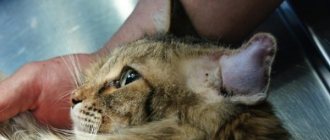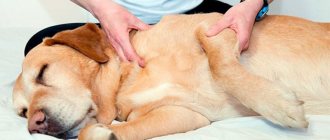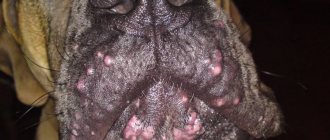Causes of subcutaneous formations
Lumps under a dog's skin are not always associated with cancer. Most of them occur for the following reasons:
- Insect bites
. Swelling on the nose often remains after an unsuccessful encounter with bees. Their bites are always accompanied by redness and swelling.
- Mechanical injury
. After an unsuccessful jump for the ball and a not at all soft landing right into the wall, a bump may appear on the face of the unlucky pet.
- Infection
. With a weakened immune system, balls filled with pus often appear. This occurs due to infection by bacteria that cause inflammation. A virus can also cause compaction.
- Inflammation of the paraanal glands
. If a lump is found under a dog’s tail, then its appearance is affected by the inflammatory process. The affected area will be itchy and painful.
- Injection
. Swelling on the thigh or paw that occurs after vaccination is a natural reaction to the injected drug. After some time it goes away on its own.
- Tick infestation
. The attached parasite can be found on the stomach, side, chest, ear, chin and even under the eye. A mysterious growth that appeared shortly after a walk requires mandatory diagnosis. Some ticks carry deadly diseases.
Disorder of the functioning of the sebaceous glands and hair follicles. When the ducts are blocked, the secreted secretion accumulates inside the gland or follicle, leading to their growth.
The prolonged presence of swelling, accompanied by its increase and the appearance of pain, requires mandatory intervention by a veterinarian. Also, other alarming symptoms that are not directly related to education may be a reason for contacting.
What symptoms may appear?
Not all balls appear under the dog's skin. Some of them are formed in soft tissues and can be diagnosed only by palpation of the affected area. Because of this, it is important to be aware of your symptoms. Alarming symptoms include:
- pain when palpating the lump;
- change in color of adjacent tissues;
- stable tumor increase;
- worsening sleep, loss of activity and appetite;
- opening of the emerging papule with subsequent release of pus or blood;
- presence of temperature.
In the absence of the listed symptoms, but the formation persists for more than 7 days, it is recommended to undergo diagnostics at a veterinary clinic. If your pet has at least one of the listed symptoms, make an appointment immediately after detecting it.
Bumps on a dog's body
A lump on a dog’s body is a compaction whose size can vary from a few millimeters to several centimeters in diameter. Such formations can be localized on different parts of the body, for example, on the back, head and limbs of the animal.
The origin of the cones can also vary. Swelling can be caused by a serious illness or a simple bee sting. Some bumps go away within a few days without any external intervention, while others cause serious discomfort and require an immediate visit to the veterinarian.
Possible causes of swelling
Types of cones in dogs
Warts and papillomas. These bumps most often appear in smooth-coated dogs. Scientists believe that a possible cause of their occurrence is the penetration of a viral infection into the pet’s body. Warts look like growths of the dermis of a dark brownish hue. As a rule, such bumps do not cause pain. In this case, a visit to the veterinarian is recommended rather for preventive purposes.
Cysts. Contrary to popular belief, a cyst can occur on any part of a pet's body. Moreover, detection of a lump usually occurs by chance and not during a routine examination. However, if the lump is located between the fingers or in the dog’s mouth, it can be easily noticed.
Hematomas. Basically, this formation is formed in the area of the animal’s ears. The occurrence of lumps is very likely in the postoperative period, especially if blood vessels have been damaged. Excessive fluid formation can also cause a hematoma. Typically, such bumps are soft to the touch and can partially change the shape of the area of the body where they are located. Hematomas rarely cause pain, although there are exceptions to this rule.
Source
Types of subcutaneous bumps in dogs
All subcutaneous formations are divided into 2 large groups: non-tumor and tumor. The former are often a consequence of another disease and go away after the root cause is eliminated. The latter are newly formed tissues that change healthy cells.
Benign
Benign neoplasms are characterized by the absence of pain and metastases. Despite this, over time they can develop into malignant ones, so the lack of timely diagnosis can lead to dire consequences.
Benign tumors grow very slowly or do not grow at all. This is explained by a special capsule that inhibits their increase. In most cases, they appear in a single copy and can affect any part of the body, including the animal’s finger.
Benign growths include:
- Keratoacanthomas
. They occur at the site of hair follicles on any part of the body covered with hair. The risk group includes shepherds.
- Histiocytomas
. It often develops into an ulcer, affecting the head and ears of the animal.
- Papillomas and warts
. Typical for pets with short hair. Most often, these tiny bumps appear under the skin of the dog on the back, genitals, paws and mucous membranes. They are usually caused by viral infections.
- Fibroids
. Almost no different from warts and reach no more than 5 cm in diameter. Usually found on the paws.
- Lipomas
. Soft, painless growths that move under the skin. An alternative name is wen. Only lipomas on the paws and carotid artery are dangerous - they can cause lameness or cause suffocation.
- Hemangiomas
. They grow from the epithelial tissue of blood vessels located on the chest. Those at risk include shepherd dogs, spaniels and retrievers.
- Histiocytoses
. They are formed from connective tissue in the form of subcutaneous nodules and plaques. Collies and shepherds are most often affected.
- Cysts
. Loose and soft red growths are found throughout the body, including where the jaws close. Cyst-shaped balls rarely cause discomfort, so the presence of pain can be a sign of degeneration into a malignant form.
The likelihood of benign tumors developing into malignant ones is always individual. In most cases, the removal of such swellings is explained by aesthetics. Mandatory surgical intervention is recommended only for sudden changes in color, bleeding and active enlargement.
Malignant
Malignant or cancerous tumors are the result of cell mutation. Due to the lack of a restraining capsule, they quickly grow and move throughout the body, affecting it with metastases.
Cancerous tumors include:
- Lymphosarcoma
. They are formed from lymphatic tissues on the joints, under the jaws, knees and in the groin area. Occur more often than others.
- Mastocytomas
. They arise from degenerated mast cells responsible for immunity. The main area of formation is the armpits, withers, groin and line along the spinal column.
- Squamous cell carcinoma
. It appears as scaly plaques or red papules that transform over time into nodular formations. Such lumps, which appear under the skin of the dog on the neck or in the mouth, quickly ulcerate and penetrate into adjacent tissues.
- Hemangiosarcomas
. There are cutaneous and subcutaneous types. The tumor under the skin is always black, but on the skin it can take on a bright pink tint. The subcutaneous form gives metastases in 60% of cases. The risk group includes pets with short white fur.
- Osteogenic sarcomas
. One of the most dangerous neoplasms that affects bone tissue. Appear on the ribs, skull, pelvis or breast bones. The risk group includes representatives of large breeds.
- Melanomas
. Round or oval spots of a dark shade that do not have a clear outline. These bumps are localized under the skin of the dog on the paws, back, eyes and mucous membranes in the mouth.
The danger of such formations lies in the absence of external symptoms at the initial stage. As the tumor metastasizes, it begins to bleed or fester. Hair falls out on the affected areas and the skin changes color. The risk group includes dogs over 8 years old.
Not tumors
In addition to bites accompanied by itching or pain, there are several other types of non-tumor formations. These include:
- Hematomas
. Seals of various sizes that appear due to damage to blood vessels, in other words, bruises.
- Pyoderma
. A purulent skin lesion often found in puppies. As a result of the disease, the body is affected by a rash or purulent papules.
- Mastitis
. Inflammation of milk bags, accompanied by the formation of lumps in the nipple area.
- Hernias
. Appear due to prolapse of abdominal organs. Their size varies from a pea to a chicken egg.
- Lymphadenitis
. A disease of the lymph nodes that causes severe pain even with slight swelling.
- Inflammation of the paraanal glands
. It clogs the excretory tract and leads to the formation of small balls resembling a hernia.
- Abscess
. Purulent tissue inflammation that occurs after unsuccessful injections, injuries or infections.
The listed seals do not disrupt the functionality of healthy cells and do not change their structure. Most of these diseases do not exclude treatment, but have much less consequences than cancerous tumors.
Lump on a dog's side under the skin
If you find a lump under your dog's skin, you should definitely show it to the veterinarian. After the research, he will make a diagnosis and prescribe appropriate treatment or surgery (depending on the type of lump).
Lumps in dogs - both harmless non-cancerous formations and malignant tumors - can appear in any part of the animal’s body, so their appearance on the side does not indicate a specific type of lump, and certainly does not indicate the presence of cancer in your pet.
Prices for appointments in our network of veterinary clinics
| Name of veterinary services | Unit | Price, rub |
| ⭐ Initial appointment | 1 animal | 400 |
| ⭐ Repeated appointment | 1 animal | 200 |
| Primary reception of ornamental, exotic animals, birds and reptiles | 1 animal | 1000 |
| Consultation without an animal | — | 500 |
| Consultation with a doctor based on test results | 1 PC. | 400 |











